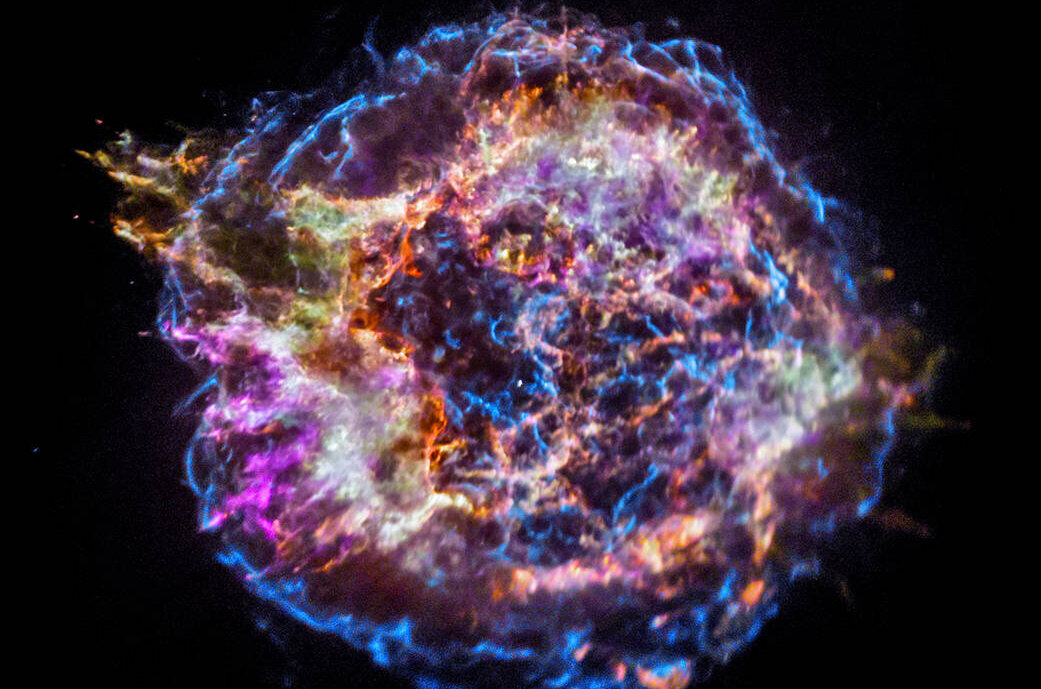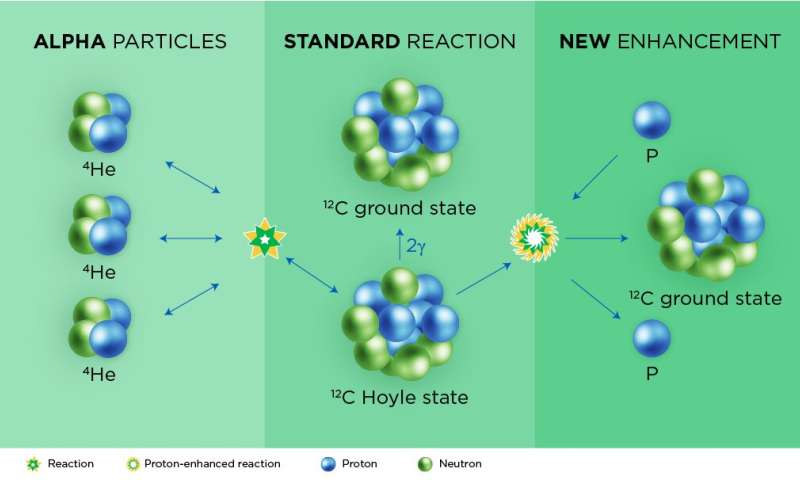
[ad_1]

Cassiopeia A is a supernova remnant in the constellation Cassiopeia. Credit: NASA / CXC / SAO
Researchers at Michigan State University (MSU) have discovered that one of the universe’s most important reactions can get a huge and unexpected boost inside explosive stars called supernovae.
This finding also challenges ideas about how some of Earth’s heavy elements are made. In particular, it overturns a theory explaining unusually high amounts of certain forms, or isotopes, of the elements ruthenium and molybdenum.
“It’s surprising,” said Luke Roberts, assistant professor at the Facility for Rare Isotope Beams, FRIB, and the Department of Physics and Astronomy, at MSU. Roberts implemented the computer code the team used to model the environment inside a supernova. “We certainly spent a lot of time making sure the results were correct.”
The results, published online on December 2 in the journal Nature, show that the innermost regions of supernovae can forge carbon atoms more than 10 times faster than previously thought. This creation of carbon occurs through a reaction known as the triple alpha process.
“The triple alpha reaction is, in many ways, the most important reaction. It defines our existence,” said Hendrik Schatz, one of Roberts’ collaborators. Schatz is Professor Emeritus in the Department of Physics and Astronomy and the Facility for Rare Isotope Beams and Director of the Joint Institute for Nuclear Astrophysics – Center for the Evolution of the Elements, or JINA-CEE.
Almost all of the atoms that make up the Earth and everything on it, including humans, were forged from stars. Fans of the late author and scientist Carl Sagan may recall his famous quote: “We are all made of stars.” Perhaps no star substance is more important to life on Earth than the carbon produced in the cosmos by the triple alpha process.
The process begins with alpha particles, which are the nuclei of helium atoms, or nuclei. Each alpha particle is made up of two protons and two neutrons.
In the triple alpha process, stars merge three alpha particles, creating a new particle with six protons and six neutrons. It is the most common form of carbon in the universe. There are other isotopes made by other nuclear processes, but these make up just over 1% of Earth’s carbon atoms.
Still, merging three alpha particles together is generally an inefficient process, Roberts said, unless something helps. The Spartan team revealed that the innermost regions of supernovae may have such floating aids: excess protons. Thus, a proton-rich supernova can accelerate the triple alpha reaction.
But the acceleration of the triple alpha reaction also slows down the supernova’s ability to make heavier elements on the periodic table, Roberts said. This is important because scientists have long believed that proton-rich supernovae created the earth’s surprising abundance of certain isotopes of ruthenium and molybdenum, which contain more than 100 protons and neutrons.

In the triple alpha process, stars merge three helium nuclei, also called alpha particles (left) to create a single carbon atom with excess energy, called the Hoyle state. This Hoyle state can split into three alpha particles or relax to the stable carbon ground state by releasing a few gamma rays (in the center). Inside supernovae, however, the creation of stable carbon can be enhanced with the help of additional protons (right). Credit: Rare Isotope Beam Facility
“You don’t make these isotopes elsewhere,” Roberts said.
But based on the new study, you’re probably not making them in proton-rich supernovae, either.
“What I find fascinating is that you now have to find another way to explain their existence. They shouldn’t be here with this abundance,” Schatz said of the isotopes. “It’s not easy to find alternatives.”
“It’s a little disappointing in a way,” said project creator Sam Austin, MSU professor emeritus and former director of the National Superconducting Cyclotron Laboratory, FRIB’s predecessor. “We thought we knew it, but we don’t know it well enough.”
There are other ideas out there, the researchers added, but none that nuclear scientists find completely satisfactory. In addition, no existing theory yet includes this new discovery.
“Whatever happens next, you have to consider the effects of an accelerated triple alpha reaction. It’s an interesting puzzle,” Schatz said.
While the team has no immediate solutions to this puzzle, the researchers said it will impact future experiments at FRIB, MSU, which was recently designated as a US Department user facility. of energy (DOE-SC).
In addition, MSU provides fertile ground for the germination of new theories. It is home to the nation’s top-ranked graduate program for training the next generation of nuclear physicists. It is also a central JINA institution that promotes collaborations in nuclear physics and astrophysics like this one, which also included Shilun Jin. Jin worked on the project as a post-doctoral fellow at MSU and has since joined the Chinese Academy of Sciences.
So while Austin expressed a little disappointment that this result contradicts long-held notions about the creation of elements, he also knows that it will fuel new science and a better understanding of the universe.
“Progress comes when there is a contradiction,” he said.
“We love progress,” Schatz said. “Even when it destroys our favorite theory.”
Experiments at a French particle accelerator probe the properties of supernovae
Shilun Jin et al, Enhanced triple-α reaction reduces proton-rich nucleosynthesis in supernovae, Nature (2020). DOI: 10.1038 / s41586-020-2948-7
Provided by Michigan State University
Quote: Supernova’s Surprise Creates Elemental Mystery (2020, December 2) retrieved December 2, 2020 from https://phys.org/news/2020-12-supernova-elemental-mystery.html
This document is subject to copyright. Apart from any fair use for study or private research, no part may be reproduced without written permission. The content is provided for information only.
[ad_2]
Source link